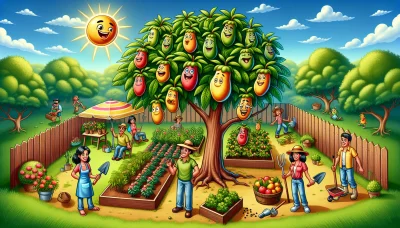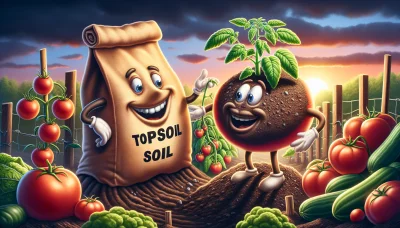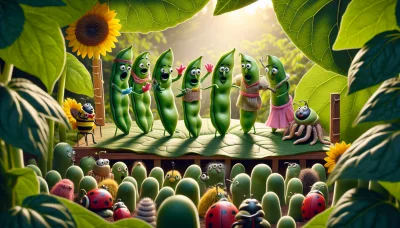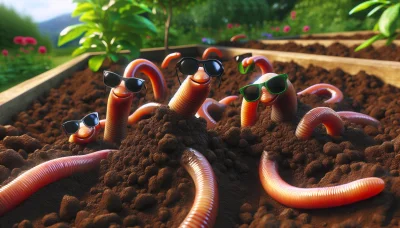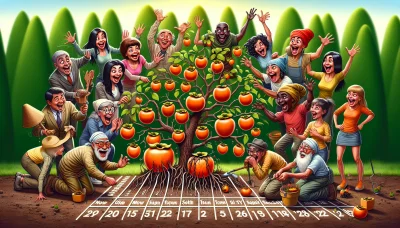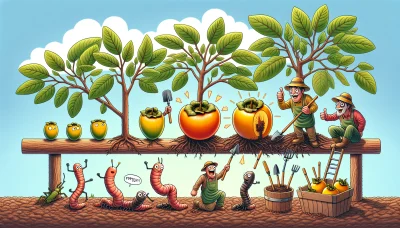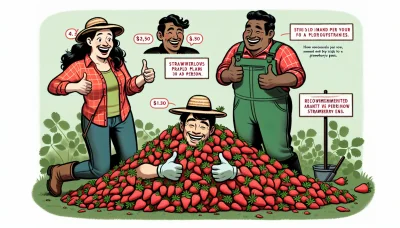Eating persimmons Quiz
Test Your Knowledge
Question of
The Joy of Eating Persimmons: A Gardener's Guide
Persimmons, with their vibrant orange hue and sweet, honey-like flavor, are a delight not only to the eyes but also to the palate. For gardeners, the joy of growing persimmons extends beyond their aesthetic appeal. These fruits are packed with nutritional benefits, offering a rich source of vitamins A and C, fiber, and antioxidants. Growing persimmons can be a rewarding endeavor, as the trees are not only productive but also add a touch of exotic beauty to any garden space. Consuming persimmons fresh from the garden allows one to fully appreciate the taste and nutritional benefits of this unique fruit, making it a worthy addition to any gardener's repertoire.
Types of Persimmons for Your Garden
- Fuyu (Non-astringent): This variety is sweet and can be eaten while still firm. It thrives in warmer climates and requires full sun exposure.
- Hachiya (Astringent): Known for its acorn shape, Hachiya persimmons are best eaten when fully ripe and soft. They need a moderate climate and plenty of sunlight.
- Chocolate Persimmon: This type has a unique, spicy-sweet flavor with a hint of chocolate. It does well in both warm and moderate climates, requiring full to partial sun.
- Tanenashi: A heart-shaped astringent variety that becomes sweet and jelly-like when ripe. It prefers warm climates and needs full sun exposure.
- American Persimmon (Diospyros virginiana): This native variety is very adaptable but prefers humid climates. It has a sweet, rich flavor when fully ripe.
- Giombo: A larger, astringent variety that becomes sweet and flavorful when ripe. It thrives in warm to moderate climates and requires full sun.
- Izu: Smaller than Fuyu but similarly sweet and non-astringent, Izu is suitable for smaller gardens. It needs full sun and does well in warm climates.
How to Plant and Care for Persimmon Trees
To start planting a persimmon tree, select a location that receives full sunlight for the majority of the day. Persimmon trees thrive in areas that get at least 6 to 8 hours of direct sun daily.
Soil preparation is crucial for persimmon trees. They prefer well-draining soil with a neutral pH. Before planting, test the soil pH and amend it if necessary to reach a pH of 6.5 to 7.5. Mix in organic compost to improve soil fertility and structure.
When you're ready to plant, dig a hole that is twice as wide and the same depth as the root ball of your persimmon tree. Gently place the tree in the hole, ensuring that the top of the root ball is level with the surrounding soil surface. Fill the hole with soil, gently tamping down to remove air pockets.
Water the newly planted tree deeply to help settle the soil around the roots. In the initial weeks, keep the soil consistently moist but not waterlogged. As the tree establishes, reduce watering frequency, allowing the top inch of soil to dry out between waterings.
Mulching around the base of the persimmon tree can help retain soil moisture, regulate soil temperature, and reduce weed competition. Apply a 2 to 3-inch layer of organic mulch, such as wood chips or straw, extending out to the drip line of the tree.
For the best growth and fruit production, ensure your persimmon tree receives at least 6 to 8 hours of sunlight daily. In areas with hot summers, some afternoon shade can be beneficial to prevent heat stress.
With proper care, your persimmon tree will grow strong and produce delicious fruits for years to come. Remember, patience is key, as it can take a few years for the tree to begin fruiting.
Harvesting and Storing Persimmons
Harvesting persimmons at the right time is crucial for ensuring they have the best taste and texture. Persimmons are typically ready to harvest in the late fall when their color has fully developed and they are slightly soft to the touch. For astringent varieties like Hachiya, it's important to wait until they are fully ripe and soft before harvesting to reduce their astringency. Non-astringent varieties like Fuyu can be harvested when they are firm and eaten crisp.
When harvesting persimmons, use pruning shears to cut the fruit from the tree, leaving a few inches of the stem attached. This helps prevent damage to the fruit and the tree. Handle the fruit gently to avoid bruising, which can lead to premature spoilage.
Storing persimmons properly can extend their shelf life and maintain their quality. Persimmons continue to ripen after being harvested, so if you have astringent varieties that are not yet soft, you can store them at room temperature until they ripen. Placing them in a paper bag with an apple or banana can speed up the ripening process due to the ethylene gas produced by these fruits.
Once persimmons are ripe, they can be stored in the refrigerator to slow down the ripening process and extend their freshness. Wrap them loosely in plastic wrap or place them in a plastic bag with some holes for ventilation, and they can last for several weeks. Be sure to check the fruit regularly and remove any that show signs of spoilage to prevent it from affecting the rest.
For longer-term storage, ripe persimmons can be peeled, pureed, and frozen. The puree can be used in smoothies, baking, or as a sweetener in various dishes. This method allows you to enjoy the delicious flavor of persimmons year-round.
Health Benefits of Persimmons
- Rich in Vitamins: Persimmons are loaded with vitamins A and C, which are essential for immune function and skin health.
- High in Fiber: The fruit promotes healthy digestion and can aid in weight management due to its high dietary fiber content.
- Contains Antioxidants: They are packed with antioxidants, which help combat oxidative stress and may reduce the risk of chronic diseases.
- Heart Healthy: Persimmons contain flavonoid antioxidants like quercetin and kaempferol, which may help lower blood pressure and reduce the risk of heart disease.
- Supports Healthy Vision: The high vitamin A content in persimmons supports good eyesight and helps prevent age-related eye diseases.
- Low in Calories: They are a low-calorie fruit, making them a healthy snack option that can fit into a variety of diets.
- Anti-Inflammatory Properties: The compounds found in persimmons have anti-inflammatory properties, which can help reduce inflammation in the body.
Delicious Persimmon Recipes for Gardeners
| Recipe Name | Ingredients | Preparation Steps |
|---|---|---|
| Persimmon Salad | Fresh persimmons, mixed greens, walnuts, feta cheese, balsamic vinaigrette | 1. Slice persimmons into thin wedges. 2. Toss with mixed greens, walnuts, and crumbled feta cheese. 3. Drizzle with balsamic vinaigrette and serve. |
| Persimmon Smoothie | Ripe persimmons, banana, almond milk, honey, cinnamon | 1. Remove the stems and seeds from the persimmons. 2. Blend persimmons with banana, almond milk, honey, and a dash of cinnamon until smooth. 3. Serve chilled. |
| Baked Persimmon Pudding | Persimmon pulp, flour, sugar, eggs, baking soda, cinnamon, nutmeg, butter | 1. Preheat oven to 350°F (175°C). 2. Mix persimmon pulp with sugar, melted butter, and eggs. 3. Combine dry ingredients separately then fold into the wet mixture. 4. Pour into a greased baking dish and bake for about 55 minutes. 5. Let cool before serving. |
| Persimmon Jam | Persimmons, sugar, lemon juice, water | 1. Peel and chop persimmons. 2. In a pot, combine persimmons with sugar, lemon juice, and water. Cook over medium heat. 3. Stir frequently until mixture thickens. 4. Cool and store in sterilized jars. |
Growing Persimmons: Common Questions Answered
Frequently Asked Questions
-
What climate is best for growing persimmons?
Persimmons thrive in temperate climates. They can tolerate temperatures as low as -25°F once established, but young trees need protection. Ideally, they require a long, warm growing season to fully ripen.
-
How much sunlight do persimmon trees need?
Persimmon trees require full sunlight to produce the best fruit. Aim for at least 6 hours of direct sunlight daily.
-
What type of soil is ideal for persimmons?
Well-draining, loamy soil with a neutral pH is ideal. They can tolerate a range of soil types, but poor drainage can lead to root rot.
-
How often should I water my persimmon tree?
Young trees need regular watering to establish roots, typically once a week. Mature trees require less frequent watering but may need more during dry spells. Over-watering can be harmful, so ensure good drainage.
-
Do persimmon trees need fertilizing?
Yes, but sparingly. Over-fertilization can lead to poor fruit quality. Use a balanced fertilizer in early spring before new growth appears.
-
When is the best time to plant persimmon trees?
The best time to plant is in late winter or early spring, after the last frost but before new growth starts.
-
How do I prune a persimmon tree?
Prune in late winter to remove dead or crossing branches and to shape the tree. Avoid heavy pruning, which can reduce fruit production.
-
How long does it take for a persimmon tree to bear fruit?
It can take 3 to 4 years for grafted trees to bear fruit and up to 7 years for trees grown from seed.
-
What are the common pests and diseases affecting persimmon trees?
Pests like fruit flies, mealybugs, and scale can be problematic. Diseases such as persimmon wilt and anthracnose may also affect trees. Regular inspection and proper care can mitigate these issues.
-
Can I grow a persimmon tree in a container?
Yes, dwarf varieties can be grown in large containers, but they require more maintenance, including regular watering and yearly repotting or root pruning.


